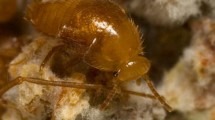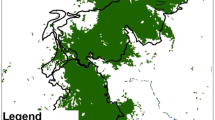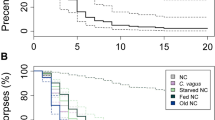Abstract
The small cockroach Attaphila paucisetosa, a myrmecophilic species, was recently reported in nests of the leafcutter ant Atta cephalotes in Southwestern Colombia. We carried out both behavioral bioassays and field observations to learn more about this cockroach-myrmecophilous association. When we excavated the nests of A. cephalotes did not found cockroaches out of the anthills. We collected all lifecycle stages of At. paucisetosa (ootheca, nymphs, male and female adults) inside of fungus chambers of the leafcutter ants’ nests. In lab, we observed that At. paucisetosa recognized artificial trails of A. cephalotes as well as worker ants. Our results show that At. paucisetosa is recognized by A. cephalotes workers as an intruder, triggering aggressive behavior, but the aggressiveness reduced in the presence of the ants’ fungus. Also, the cockroach may use foraging trails and its attachment abilities to ride on foraging ant, facilitating the entrance to the stablished colonies, but the cockroach must take risks (from being mutilated or killed) since it is recognized as an intruder, so it takes advantage of its small size to try to find refuge in the fungus crevices, taking recognition profile hydrocarbons from the ants.





Similar content being viewed by others
Data Availability
Data sharing not applicable to this article as no datasets were generated or analyzed during the current study.
References
Akre RD, Torgerson RL (1969) Behavior of Vatesus beetles associated with army ants (Coleoptera: Staphylinidae). Pan-Pac Entomol 45:269–281
Adams RMM, Wells RL, Yanoviak SP, Frost CJ, Fox EGP (2020) Interspecific eavesdropping on ant chemical communication. Front Ecol Evol 8:24
Akino T (2008) Chemical strategies to deal with ants: a review of mimicry, camouflage, propaganda, and phytomimesis by ants (Hymenoptera: Formicidae) and other arthropods. Myrmecol News 11:173–181
Allan R, Elgar M (2001) Exploitation of the green tree ant, Oecophylla smaragdina, by the salticid spider Cosmophasis bitaeniata. Aust J Zool 49:129–137
Bates D, Machler M, Bolker BM (2011) lme4: Linear mixed-effects models using s4 classes. http://cran.R-project.org/package=lme4.Rpackageversion0.999375-42.
Beccaloni, GW (2014). Cockroach Species File Online. Version 5.0/5.0. World Wide Web electronic publication. http://Cockroach.SpeciesFile.org. Accessed 3 September 2020.
Bolivar I (1905) Les blattes myrmécophiles. Mitt Schwei Entomol Ges 3:134–141
Bohn H, Nehring V, Rodríguez J, Klauss-Dieter K (2021) Revision of the genus Attaphila (Blattodea: Blaberoidea) myrmecophiles living in the mushroom gardens of leaf-cutting ants. Arthropods Syst Phylogeny 79:205–280
Brossut R (1976) Étude morphologique de la blatte myrmécophile Attaphila fungicola Wheeler. Insectes Soc 23:167–174
Buschinger A (2009) Social parasitism among ants: a review (Hymenoptera: Formicidae). Myrmecol News 12:219–35
Cristiano MP, Cardoso DC, Sandoval-Gómez VE (2020) Amoimyrmex gen. nov. and relevant taxonomic changes attributed to Cristiano, M. P.; Cardoso, D. C.; Sandoval-Gómez, V. E. Pp. 647–674 in: Cristiano MP, Cardoso DC, Sandoval-Gómez VE, Simões-Gomes F (2020) Amoimyrmex Cristiano, Cardoso and Sandoval, gen. nov. (Hymenoptera: Formicidae): a new genus of leaf-cutting ants revealed by multilocus molecular phylogenetic and morphological analyses. Austral Entomol. 59: 643–676
d’Ettorre P, Errard C, Ibarra F, Francke W, Hefetz A (2000) Sneak in or repel your enemy: Dufour’s gland repellent as a strategy for successful usurpation in the slave-maker Polyergus rufescens. Chemoecology 10:135–142
d’Etorre P, Deisig N, Sandoz JC (2017) Decoding ants’ olfactory system sheds light on the evolution of social communication. Proc Nat Acad Sci 114:8911–8913
di Giulio A, Maurizi E, Hlaváč P, Moore W (2011) The long-awaited first instar larva of Paussus favieri (Coleoptera: Carabidae: Paussini). Eur J Entomol 108:127–138
Guerrieri FJ, Nehring V, Jorgensen CG, Nielsen J, Galizia CG, d’Ettorre P (2009) Ants recognize foes and not friends. Proc R Soc Lond [b] 276:2461–2468
Hölldobler B, Wilson EO (1990) The ants. Belknap press of Harvard University Press, Cambridge, MA
Jackman S (2008) Classes and methods for R developed in the political science. Computational Laboratory, Stanford University. Department of Political Science, Stanford University, Stanford, California. R package version 0.95
Jaffé K (1983) Chemical communications systems in the ant Atta cephalotes. In: Johnson K, Jaisson P (eds) Social Insects in the Tropics. Presses de l’Université Paris-Nord, France, pp 165–180
Kistner DH (1979) Social and evolutionary significance of social insect symbionts. In: Hermann HR (ed) Social Insects. Academic Press, New York, pp 339–413
Kistner DH (1982) The social insects’ bestiary. In: Hermann HR, editor. Social Insects. New York: Academic Press; 1982. p. 1–244
Larsen J, Fouks B, Bos N, d’Ettorre P, Nehring V (2014) Variation in nestmate recognition ability among polymorphic leaf-cutting ant workers. J Ins Physiol 70:59–66
Maurizi E, Fattorini S, di Giulio A (2012) Behavior of Paussus favieri (Coleoptera, Carabidae, Paussini), a myrmecophilous beetle associated with Pheidole pallidula (Hymenoptera, Formicidae). Psyche 1–9
Mendoça CAF, Pesquero MA, Carvalho RSD, Arruda FV (2019) Myrmecophily and myrmecophagy of Attacobius lavape (Araneae: Corinnidae) on Solenopsis saevissima (Hymenoptera: Myrmicinae). Sociobiology 66:545–550
Montoya-Correa M., Montoya-Lerma J, Armbrecht I, Ropero MCG (2007) ¿Cómo responde la hormiga cortadora de hojas Atta cephalotes (Hymenoptera: Myrmicinae) a la remoción mecánica de sus nidos? – Boletín del Museo de Entomología de la Universidad del Valle 8: 1–8.
Moser JC (1964) Inquiline roach responds to trail-marking substance of leaf-cutting ants. Science 143:1048–1049
Moser JC, Blum MS (1963) Trail marking substance of the Texas leaf-cutting ant: Source and potency. Science 140:1228
Nehring V, Dani FR, Calamai L, Turillazzi S, Bohn H, Klass KD, d’Ettorre P (2016) Chemical disguise of myrmecophilous cockroaches and its implications for understanding nestmate recognition mechanisms in leaf-cutting ants. BMC Ecol 16:1–11
Nehring V, Dani FR, Turillazzi S, Boomsma JJ, d’Ettorre P (2015) Integration strategies of a leaf-cutting ant social parasite. Anim Behav 108:55–65
Nowbahari E, Fénéron R, Malherbe MC (1999) Effect of body size on aggression in the ant, Cataglyphis niger (Hymenoptera; Formicidae). Aggressive Behav 25:369–379
Parker J (2016) Myrmecophily in beetles (Coleoptera): Evolutionary patterns and biological mechanisms. Myrmecol News 22:65–108
Parmentier T, Dekoninck W, Wenseleers T (2016) Survival of persecuted myrmecophiles in laboratory nests of different ant species can explain patterns of host use in the field (Hymenoptera: Formicidae). Myrmecol News 23:71–79
Parmentier T, Vanderheyden A, Dekoninck W, Wenseleers T (2017) Body size in the ant-associated isopod Platyarthrus hoffmannseggii is host-dependent. Biol J Linn Soc Lond 121:305–311
Phillips ZI (2021) Emigrating together but not establishing together: A cockroach rides ants and leaves. Am Nat 197
Phillips ZI, Reding L, Farrior CE (2021) The early life of a leaf-cutter ant colony constrains symbiont vertical transmission and favors horizontal transmission. Ecol Evol 11:11718–11729
Phillips ZI, Zhang MM, Mueller UG (2017) Dispersal of Attaphila fungicola, a mutualistic cockroach of leaf-cutter ants. Insectes Soc 64:277–284
Rettenmeyer CW (1963) The behavior of Thysanura found with army ants. Ann Entomol Soc Am 56:170–174
R Core Team (2020) R: A language and environment for statistical computing. Vienna, Austria: R foundation for Statistical Computing
Rodríguez J, Montoya-Lerma J, Calle Z (2013) Primer registro de Attaphila fungicola (Blattaria: Polyphagidae) en nidos de Atta cephalotes (Hymenoptera: Myrmicinae) en Colombia. Bol Cient Mus His Nat 17:219–225
von Beeren C, Schulz S, Hashim R, Witte V (2011) Acquisition of chemical recognition cues facilitates integration into ant societies. BMC Ecol 11:30
Waller DA, Moser JC (1990) Invertebrate enemies and nest associates of the leaf-cutting ant Atta texana (Buckley) (Formicidae, Attini). In: Vander Meer RK, Jaffé K, Cedena A (eds) Applicated Myrmecology. Westview Press, A world Perspective, pp 256–273
Wheeler WM (1900) A new myrmecophile from the mushroom gardens of the Texan leaf-cutting ant. Am Nat 34:851–862
Witte V, Foitzik S, Hashim R, Maschwitz U, Schulz S (2009) Fine tuning of social integration by two myrmecophiles of the Ponerine army ant, Leptogenys distinguenda. J Chem Ecol 35:355–367
Zubarán GE, Di Iorio OR (2020) The genus Attaphila Wheeler, 1900 (Blattaria: Polyphagidae) in Argentina. Historia Natural 10:219–228
Acknowledgements
We thank Elsy Alvear and Sayra Mina for their support in collecting and maintaining ant colonies, and Cristian Roman Palacios for his comments and technical support in statistical analysis. In addition, the authors thank GEAHNA (Grupo de Investigaciones de Ecología de Agrosistemas y Hábitats Naturales) for providing laboratory facilities, and Dr. Horst Bohn, Germany for identifying of the roach species. Special thanks to Professor William Eberhard for his valuable comments.
Funding
This study did not receive any founding resources.
Author information
Authors and Affiliations
Contributions
BOJ and JR conceived the idea and designed the study. BOJ and JR collected the nest samples. BOJ performed the experiments, analyzed the recordings, took the pictures, and provided the first draft. BOJ, JR, and JML wrote and edited the manuscript.
Corresponding author
Ethics declarations
Compliance with Ethical Standards
No approval of research ethics committees was required to accomplish the goals of this study because experimental work was conducted with an unregulated invertebrate species. The study was carried out under the collection permit granted by the environmental licensing authority (ANLA) to the Universidad del Valle (Resolution 1070 issued on August 28, 2015).
Financial Interests
The authors have no financial or proprietary interests in any material discussed in this article.
Conflict of Interest
The authors declare that they have no conflict of interest.
Additional information
Publisher's Note
Springer Nature remains neutral with regard to jurisdictional claims in published maps and institutional affiliations.
Supplementary Information
Below is the link to the electronic supplementary material.
Rights and permissions
About this article
Cite this article
Ospina-Jara, B., Rodríguez, J. & Montoya-Lerma, J. Intruders in the Nest: Interaction of Attaphila paucisetosa (Blattodea: Blaberoidea) with Atta cephalotes Workers (Hymenoptera: Formicidae). J Insect Behav 35, 1–10 (2022). https://doi.org/10.1007/s10905-022-09794-4
Received:
Revised:
Accepted:
Published:
Issue Date:
DOI: https://doi.org/10.1007/s10905-022-09794-4




